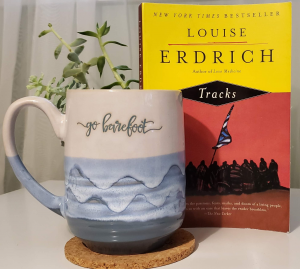
My favourite tea mug along side Indigenous author Louis Erdrich’s book, “Tracks”, which I highly recommend if you haven’t read it already. This story is an excellent one that deals with the loss of heritage and land through the eyes of fictional Ojibwe peoples.
Greetings and salutations! Welcome to my first ever blog, which is bound to be a rich source of my inner mind as I navigate through English 372 99C.
A little about me: I’m an English Literature major with a minor in Medieval Studies. My pathway at UBC has been an interesting one to say the least. With the mix of my major and minor, I have elicited the opportunity to take a lot of courses studying cultures around the world through their history as well as their literature. Funny enough, I didn’t think to look into my own backyard until my final year as an Undergrad. This is my second course that has a focus on Indigenous literature, and my first that focuses mainly on Canadian literature.
I have been introduced to Thomas King previously through his non-fictive book titled The Inconvenient Indian. While my previous professor, Dr. Dory Nason, only had us read the first few chapters, my impression of King’s book is that it is a good resource to understand the history of Indigenous people within North America. Though like any history book, the book itself has its strong points and its weak points; part of the reason why Dr. Nason had us read other Indigenous writers on Indigenous women.
Beyond that of written literature, Alanis Obomsawin, and Indigenous documentarian, has some interesting short films and documentaries on the Nation Film Board of Canada website (found here: NFB). Obomsawin was another source I was introduced to through my previous Indigenous literature studies course. While I have not watched all of Obomsawin’s work, the few that I have were really enlightening. In particular her documentary titled Hi Ho Mistahey! is an excellent piece documenting the troubles of schooling on Indigenous reserves and the fight for funding started by the late Shannen Koostachin.
Based on my previous exploits into Indigenous literature, I have some ideas as to what to expect for ENGL 372. However, I recognize that this course is taking a different approach. Where my previous experience delved more into the non-fictive literature – there was some fiction such as Louis Erdrich’s Tracks, another highly recommended text – I expect this course to deal more with the fictive stories written by Canadian Indigenous authors.
The fun thing about literature is that you never know how a story is going to affect you until you’ve read it. You never know what ideas will stem from one sentence that will lead you down the research rabbit hole. So, join me by grabbing your steaming cup of tea and let’s dive in!
Works Cited
“The Inconvenient Indian.” CBC.ca. CBC Books, 2017. https://www.cbc.ca/books/the-inconvenient-indian-1.3972080. Accessed 16 January 2021.
“Alanis Obosawin.” NFB.ca. Directors, 2021. https://www.nfb.ca/directors/alanis-obomsawin/ Accessed 16 January 2021.